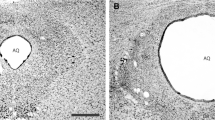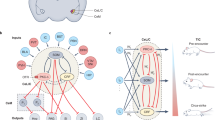Abstract
In this study, we have aimed at outlining the neural systems underlying the expression of contextual fear to social defeat. First, we have developed an experimental procedure, where defeated animals could express, without the presence of a dominant aggressive male, robust and reliable conditioned fear responses to the context associated with social defeat. Next, by examining the pattern of Fos expression, we have been able to outline a brain circuit comprising septal and amygdalar sites, as well as downstream hypothalamic paths, putatively involved in the expression of contextual fear to social threat. Of particular relevance, we have found that exposure to a defeat-associated context results in a striking Fos up-regulation in the dorsomedial part of the dorsal premammillary nucleus (PMDdm). To further understand the role of the PMDdm in the circuit organizing conditioned fear to social threats, we have been able to observe that pharmacological blockade of the PMDdm reduced fear responses to a social defeat-associated context. Next, we observed that pharmacological blockade of the dorsomedial part of the periaqueductal gray, one of the main targets of the PMDdm, produced an even higher reduction of conditioned fear in defeated intruders, and appears as an important node for the expression of contextual defensive responses to social threats. The present results help to elucidate the basic organization of the neural circuits underlying contextual conditioned responses to social defeat, and reveal that they share at least part of the same circuit involved in innate responses to social defeat to an aggressive conspecific.






Similar content being viewed by others
References
Bandler R, Carrive P, Depaulis A (1991) Emerging principles of organization of the midbrain periaqueductal gray matter. In: Depaulis A, Bandler R (eds) The midbrain periaqueductal gray matter: functional, anatomical, and neurochemical organization. Plenum Press, New York, pp 1–8
Blanchard DC, Blanchard RJ (1991) Behavioral correlates of chronic dominance-subordination relationships of male rats in a seminatural situation. Neurosci Biobehav Rev 14:455–462
Blanchard RJ, Blanchard DC, Hori K (1989) Etho experimental approaches to the study of defensive behavior. In: Blanchard RJ, Brain PF, Blanchard DC, Parmigiani S (eds) Ethoexperimental approaches to the study of behavior. Kluwer Academic Publishers, Dordrecht, pp 114–136
Bolhuis J, Fitzgerald R, Dijk D, Koolhaas J (1984) The corticomedial amygdala and learning in an agonistic situation in the rat. Physiol Behav 32:575–579
Canteras N, Simerly R, Swanson L (1995) Organization of projections from the medial nucleus of the amygdala: a PHAL study in the rat. J Comp Neurol 360:213–245
Carrive P, Leung P, Harris J, Paxinos G (1997) Conditioned fear to context is associated with increased Fos expression in the caudal ventrolateral region of the midbrain periaqueductal gray. Neuroscience 78:165–177
Cezario A, Ribeiro-Barbosa E, Baldo M, Canteras N (2008) Hypothalamic sites responding to predator threats–the role of the dorsal premammillary nucleus in unconditioned and conditioned antipredatory defensive behavior. Eur J Neurosci 28:1003–1015
Corrigan J, Flannelly K (1979) Ultrasonic vocalizations of defeated male rats. J Comp Physiol Psychol 93:105–115
Day DE, Cooper MA, Markham CM, Huhman KL (2011) NR2B subunit of the NMDA receptor in the basolateral amygdala is necessary for the acquisition of conditioned defeat in Syrian hamsters. Behav Brain Res 217:55–59
Elliott E, Ezra-Nevo G, Regev L, Neufeld-Cohen A, Chen A (2010) Resilience to social stress coincides with functional DNA methylation of the Crf gene in adult mice. Nat Neurosci 13:1351–1353
Fanselow MS, Sigmundi RA (1986) Species-specific danger signals, endogenous opioid analgesia, and defensive behavior. J Exp Psychol Anim Behav Process 12:301
Floyd NS, Price JL, Ferry AT, Keay KA, Bandler R (2000) Orbitomedial prefrontal cortical projections to distinct longitudinal columns of the periaqueductal gray in the rat. J Comp Neurol 422:556–578
French S, Totterdell S (2003) Individual nucleus accumbens-projection neurons receive both basolateral amygdala and ventral subicular afferents in rats. Neuroscience 119:19–31
Goto M, Canteras NS, Burns G, Swanson LW (2005) Projections from the subfornical region of the lateral hypothalamic area. J Comp Neurol 493:412–438
Gross CT, Canteras NS (2012) The many paths to fear. Nat Rev Neurosci 13:651–658
Hahn JD, Swanson LW (2012) Connections of the lateral hypothalamic area juxtadorsomedial region in the male rat. J Comp Neurol 520:1831–1890
Lai WS, Johnston RE (2002) Individual recognition after fighting by golden hamsters: a new method. Physiol Behav 76:225–239
Landgraf R, Neumann ID (2004) Vasopressin and oxytocin release within the brain: a dynamic concept of multiple and variable modes of neuropeptide communication. Front Neuroendocrinol 25:150–176
Luckett C, Norvelle A, Huhman K (2011) The role of the nucleus accumbens in the acquisition and expression of conditioned defeat. Behav Brain Res 227:208–214
Luiten P, Koolhaas J, De Boer S, Koopmans SJ (1985) The cortico-medial amygdala in the central nervous system organization of agonistic behavior. Brain Res 332:283–297
Markham C, Huhman K (2008) Is the medial amygdala part of the neural circuit modulating conditioned defeat in Syrian hamsters? Learn Mem 15:6–12
Markham C, Norvelle A, Huhman K (2009) Role of the bed nucleus of the stria terminalis in the acquisition and expression of conditioned defeat in Syrian hamsters. Behav Brain Res 198:69–73
Markham CM, Taylor SL, Huhman KL (2010) Role of amygdala and hippocampus in the neural circuit subserving conditioned defeat in Syrian hamsters. Learn Mem 17:109–116
Markham CM, Luckett CA, Huhman KL (2011) The medial prefrontal cortex is both necessary and sufficient for the acquisition of conditioned defeat. Neuropharmacology 62:933–939
McDonald MM, Markham CM, Norvelle A, Albers HE, Huhman KL (2011) GABAA receptor activation in the lateral septum reduces the expression of conditioned defeat and increases aggression in Syrian hamsters. Brain Res 1439:27–33
Mogenson GJ, Jones DL, Yim CY (1980) From motivation to action: functional interface between the limbic system and the motor system. Prog Neurobiol 14:69–97
Motta SC, Goto M, Gouveia FV, Baldo MVC, Canteras NS, Swanson LW (2009) Dissecting the brain’s fear system reveals the hypothalamus is critical for responding in subordinate conspecific intruders. Proc Natl Acad Sci 106:4870–4875
Potegal M, Huhman K, Moore T, Meyerhoff J (1993) Conditioned defeat in the Syrian golden hamster (Mesocricetus auratus) 1. Behav Neural Biol 60:93–102
Razzoli M, Roncari E, Guidi A, Carboni L, Arban R, Gerrard P, Bacchi F (2006) Conditioning properties of social subordination in rats: behavioral and biochemical correlates of anxiety. Horm Behav 50:245–251
Razzoli M, Carboni L, Guidi A, Gerrard P, Arban R (2007) Social defeat-induced contextual conditioning differentially imprints behavioral and adrenal reactivity: a time-course study in the rat. Physiol Behav 92:734–740
Ribeiro-Barbosa E, Canteras N, Cezario A, Blanchard R, Blanchard D (2005) An alternative experimental procedure for studying predator-related defensive responses. Neurosci Biobehav Rev 29:1255–1263
Risold P, Swanson L (1996) Structural evidence for functional domains in the rat hippocampus. Science 272:1484–1486
Risold P, Swanson L (1997) Connections of the rat lateral septal complex. Brain Res Rev 24:115–195
Scalia F, Winans SS (1975) The differential projections of the olfactory bulb and accessory olfactory bulb in mammals. J Comp Neurol 161:31–55
Shinonaga Y, Takada M, Mizuno N (1994) Topographic organization of collateral projections from the basolateral amygdaloid nucleus to both the prefrontal cortex and nucleus accumbens in the rat. Neuroscience 58:389–397
Swanson LW (2000) Cerebral hemisphere regulation of motivated behavior 1. Brain Res 886:113–164
Swanson LW (2004) Brain maps: structure of the rat brain. Elsevier, Amsterdam
Swanson L, Petrovich G (1998) What is the amygdala? Trends Neurosci 21:323–331
Thor DH, Flannelly KJ (1976) Age of intruder and territorial-elicited aggression in male Long-Evans rats. Behav Biol 17:237–241
van Wimersma Greidanus TB, Maigret C (1996) The role of limbic vasopressin and oxytocin in social recognition. Brain Res 713:153–159
Vochteloo J, Koolhaas J (1987) Medial amygdala lesions in male rats reduce aggressive behavior: interference with experience. Physiol Behav 41:99–102
Acknowledgments
This research was supported by grants from Fundação de Amparo à Pesquisa do Estado de São Paulo (FAPESP, no. 2011/02425-3) and Conselho Nacional de Desenvolvimento Científico e Tecnológico awarded to N.S.C., C.B.F and M.J.R. Jr. were supported by FAPESP fellowships.
Author information
Authors and Affiliations
Corresponding author
Additional information
C. B. Faturi and M. J. Rangel participated equally in this study.
Rights and permissions
About this article
Cite this article
Faturi, C.B., Rangel, M.J., Baldo, M.V.C. et al. Functional mapping of the circuits involved in the expression of contextual fear responses in socially defeated animals. Brain Struct Funct 219, 931–946 (2014). https://doi.org/10.1007/s00429-013-0544-4
Received:
Accepted:
Published:
Issue Date:
DOI: https://doi.org/10.1007/s00429-013-0544-4




